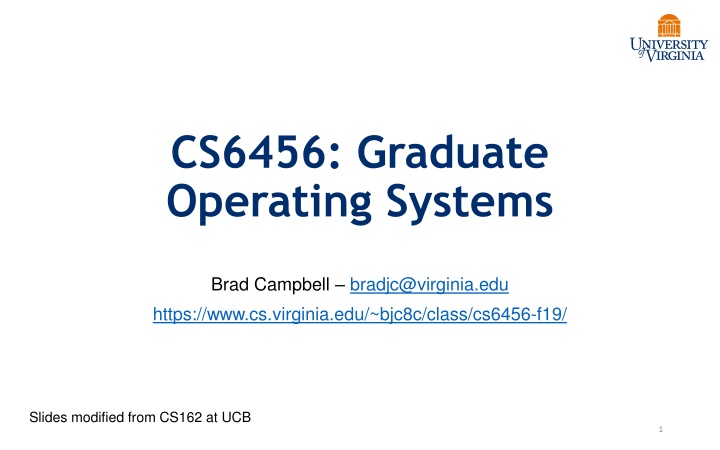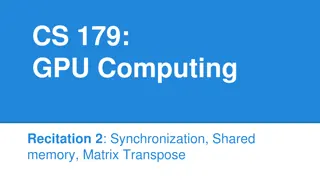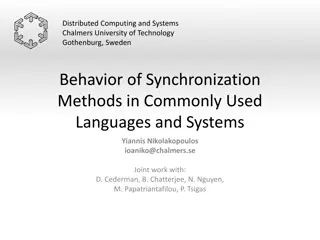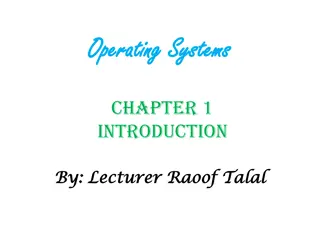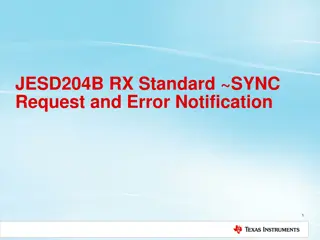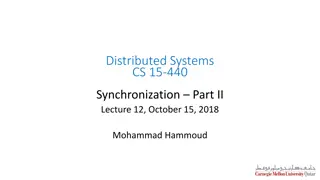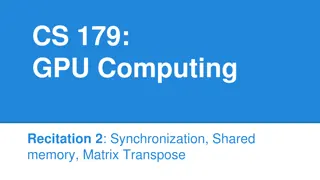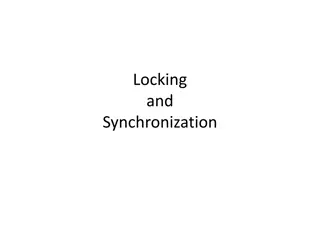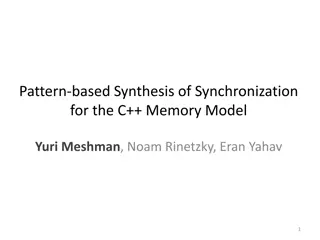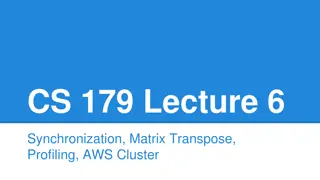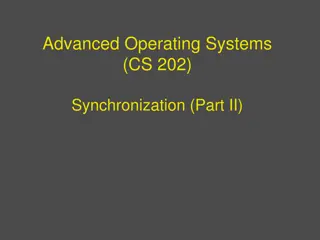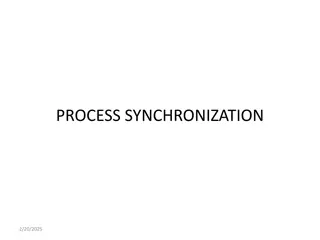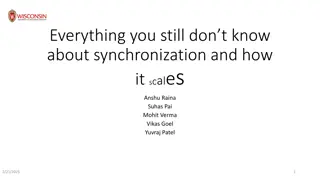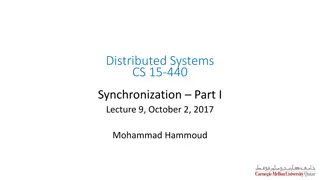Synchronization Mechanisms in Operating Systems
This content delves into the fundamental concepts of semaphores, locks, and synchronization in operating systems. Exploring the implementation of locks, the use of atomic instructions, and the historical perspective of semaphores. Discover the significance of these synchronization mechanisms and their impact on concurrency in computer systems.
Download Presentation

Please find below an Image/Link to download the presentation.
The content on the website is provided AS IS for your information and personal use only. It may not be sold, licensed, or shared on other websites without obtaining consent from the author.If you encounter any issues during the download, it is possible that the publisher has removed the file from their server.
You are allowed to download the files provided on this website for personal or commercial use, subject to the condition that they are used lawfully. All files are the property of their respective owners.
The content on the website is provided AS IS for your information and personal use only. It may not be sold, licensed, or shared on other websites without obtaining consent from the author.
E N D
Presentation Transcript
CS6456: Graduate Operating Systems Brad Campbell bradjc@virginia.edu https://www.cs.virginia.edu/~bjc8c/class/cs6456-f19/ Slides modified from CS162 at UCB 1
Today: Scheduler if ( readyThreads(TCBs) ) { nextTCB = selectThread(TCBs); run( nextTCB ); } else { run_idle_thread(); } Scheduler: Which thread should run on the CPU next?
Evaluating Schedulers Defining key metrics Response Time (ideally low) What user sees: from keypress to character on screen Throughput (ideally high) Total operations per second Problem: Overhead (e.g. from context switching) Fairness Conflicts with best avg. throughput/resp. time
First-Come First-Served (FCFS) Also: "First In First Out" Example: Process Burst Time P1 P2 P3 Arrival Order: P1, P2, then P3 24 3 3 P1 P2 P3 0 24 27 30
First-Come First-Served (FCFS) P1 P2 P3 0 24 27 30 Response Times: P1 = 24, P2 = 27, P3 = 30 Waiting times: P1 = 0, P2 = 24, P3 = 27 Average Response Time = (24+27+30)/3 = 27 Average Wait Time = (0 + 24 + 27)/3 = 17 Convoy Effect: Short processes stuck behind long processes
What if the arrival order changes? P2 P3 P1 0 3 6 30 Waiting Time: P1 = 6, P2 = 0, P3 = 3 Average Waiting Time = (6+0+3)/3 = 3 Response Time: P1 = 30, P2 = 3, P3 = 6 Last Time: 17 Average Response Time = (30 + 3 + 6)/3 = 13 Last Time: 27
Round Robin Give out small units of CPU time ("time quantum") Typically 10 100 milliseconds When quantum expires, preempt, add to end of the queue Each of N processes gets 1/N of CPU With quantum length Q ms, process waits at most (N-1)*Q ms to run again Downside: More context switches What should Q be? Too high: back to FCFS, Too Low: context switch overhead
Round Robin Example (Q = 20) P1 P2 P3 P4 P1 P3 P4 P1 P3 P3 0 20 28 48 68 88 108 112 125 145 153 Example: Waiting time for Average waiting time = (72+20+85+88)/4 = 66.25 Average response time = (125+28+153+112)/4 = 104.5 And don't forget context switch overhead! Process P1 P2 P3 P4 Burst Time 53 8 68 24 P1=(68-20)+(112-88)=72 P2=(20-0)=20 P3=(28-0)+(88-48)+(125-108)=85 P4=(48-0)+(108-68)=88
Round Robin Overhead Typical Context Switch: 0.1ms 100ms With 10ms 100ms time quantum (Q): ~1% Overhead
Round Robin Quantum Assume there is no context switching overhead What happens when we decrease Q? Avg. response time increases decreases stays the same or some combination?
Decrease Response Time P1: Burst Length 10 P2: Burst Length 1 Q = 10 P1 P2 0 11 10 Average Response Time = (10 + 11)/2 = 10.5 Q = 5 P1 P2 P1 0 11 5 6 Average Response Time = (6 + 11)/2 = 8.5
Same Response Time P1: Burst Length 1 P2: Burst Length 1 Q = 10 P1 P2 1 0 2 Average Response Time = (1 + 2)/2 = 1.5 Q = 1 P1 P2 1 0 2 Average Response Time = (1 + 2)/2 = 1.5
Increase Response Time P1: Burst Length 1 P2: Burst Length 1 Q = 1 P1 P2 1 0 2 Average Response Time = (1 + 2)/2 = 1.5 Q = 0.5 2 0 Average Response Time = (1.5 + 2)/2 = 1.75
Priority Scheduling Priority 3 Job 1 Job 3 Job 2 Priority 2 Job 4 Priority 1 Priority 0 Job 5 Job 6 Job 7 Always run the ready thread with highest priority Systems may try to set priorities according to some policy goal Example: Give shell higher priority than long calculation Prefer jobs waiting on I/O to those consuming lots of CPU Try to achieve fairness: elevate priority of threads that don't get CPU time (ad-hoc, bad if system overload)
What if we know how much time each process needs in advance? Non-preemptive: Shortest Job First Like FCFS if we always chose the best possible ordering Preemptive Version: Shortest Remaining Time First A newly ready process (e.g., just finished an I/O operation) with shorter time replaces the current one
Shortest Job/Remaining Time First Provably Optimal with respect to Response Time Key Idea: remove convoy effect Short jobs always stay ahead of long ones Starvation is possible What if new short jobs keep arriving?
SRTF Example Three jobs in system A and B are CPU calculations that take 1 week to run C: Continuous loop of 1ms CPU time, 9ms of I/O time C A or B C s I/O C s I/O C s I/O FCFS? A or B starve C I/O throughput problem: lose opportunity to do work for C while CPU runs A or B
SRTF Example Disk Utilization: 9/201 ~ 4.5% C A B C Disk Utilization: ~90% but lots of wakeups! RR 100ms time slice C s I/O C s I/O CABAB C RR 1ms time slice C s I/O C s I/O Disk Utilization: 90% C A A A SRTF C s I/O C s I/O
Shortest Job/Remaining Time First How do we know the time a job/process will take? Usually, we don't Ask the users? They can try to estimate Or just lie Observe past process behavior Past behavior is good indicator of future behavior
Multi-Level Feedback Scheduling Long-Running Compute Tasks Demoted to Low Priority Multiple queues, each of different priority Round Robin within each queue Different quantum length for each queue Favor I/O-bound jobs
Multi-Level Feedback Scheduling Long-Running Compute Tasks Demoted to Low Priority Intuition: Priority Level proportional to burst length Job Exceeds Quantum: Drop to lower queue Job Doesn't Exceed Quantum: Raise to higher queue
Multi-Level Feedback Scheduling What about starvation? Long-running jobs fall into low priority, may never get the CPU Time-slice among the queues (e.g., 70% to highest priority, 20% to middle, 10% to low) Artificially boost priority of a starved job These solutions improve fairness but hurt response time
https://twitter.com/GoingGrayTA/status/1090065890253656064 29
Brads thoughts Unfortunate property of grad school: if you aren t working on your work, no one else is It is your degree you are pursuing However, success is not equivalent to constant work Important to remember that progress often comes in spurts Things that helped me: Realizing that that there are a lot of metrics for progress Using conferences as an excuse to explore new places Having a pre-scheduled weekly fun event to look forward to 30
Linux Completely Fair Scheduler Goal: Each process gets an equal share of CPU N threads "simultaneously" execute on 1/Nth of CPU At any time t we would observe: CPU Time t/N T1 T2 T3
Linux Completely Fair Scheduler Can't do this with real hardware Still need to give out full CPU in time slices Instead: track CPU time given to a thread so far Scheduling Decision: "Repair" illusion of complete fairness Choose thread with minimum CPU time CPU Time t/N T1 T3 T2
Linux CFS Constraint 1: Target Latency Period of time over which every process gets service Preserves response time Target Latency: 20ms, 4 Processes Each process gets 5ms time slice Target Latency: 20 ms, 200 Processes Each process gets 0.1ms time slice Recall Round-Robin: Huge context switching overhead
Linux CFS Constraint 2: Minimum Granularity Minimum length of any time slice Protects throughput Target Latency 20ms, Minimum Granularity 1ms, 200 processes Each process gets 1ms time slice
Linux CFS What if we want to use nice to change priority? Key Idea: Assign a weight wito each process i Originally: ? = Target Latency 1 ? Now: ??= (??/ ???) Target Latency
Linux CFS Target Latency = 20ms, Minimum Granularity = 1ms Two CPU-Bound Threads Thread A has weight 1 Thread B has weight 4 Time slice for A? 4 ms Time slice for B? 16 ms
Linux CFS Track a thread's virtual runtime rather than its true physical runtime Higher weight: Virtual runtime increases more slowly Lower weight: Virtual runtime increases more quickly 16 Physical CPU Time B 4 A
Linux CFS Track a thread's virtual runtime rather than its true physical runtime Higher weight: Virtual runtime increases more slowly Lower weight: Virtual runtime increases more quickly Virtual CPU Time Actually Used for Decisions A B
Real-Time Scheduling Goal: Guaranteed Performance Meet deadlines even if it means being unfair or slow Limit how bad the worst case is Hard real-time: Meet all deadlines (if possible) Ideally: determine in advance if this is possible
Real-Time Example Preemptible tasks with known deadlines (D) and known burst times (C)
Earliest Deadline First Priority scheduling with preemption Priority proportional to time until deadline Example with periodic tasks: 1= T ) 1 , 4 ( 2= T ) 2 , 5 ( 3= T ) 2 , 7 ( 0 5 10 15
EDF: Feasibility Testing Even EDF won't work if you have too many tasks For n tasks with computation time C and deadline D, a feasible schedule exists if: ? ?? ?? 1 ?=1
Choosing the Right Scheduler I Care About: Then Choose: CPU Throughput FCFS Avg. Response Time SRTF Approximation I/O Throughput SRTF Approximation Fairness (CPU Time) Linux CFS Fairness Round Robin (Wait Time to Get CPU) Meeting Deadlines EDF Favoring Important Tasks Priority
Priority and Locks Priority 3 Job 3 Priority 2 Job 2 Job 1 Priority 1 holds At this point, which job does the scheduler choose? Job 3 (Highest Priority)
Priority and Locks Acquire() Priority 3 Job 3 Priority 2 Job 2 Job 1 Priority 1 Job 3 attempts to acquire lock held by Job 1
Priority and Locks Blocked on Acquire Job 3 Priority 3 Priority 2 Job 2 Job 1 Priority 1 At this point, which job does the scheduler choose? Job 2 (Medium Priority) Priority Inversion
Solution: Priority Donation Job 1 Priority 3 Release() Priority 2 Job 2 Priority 1 Job 3 temporarily grants Job 1 its highest priority to run on its behalf
Priority and Locks Priority 3 Job 3 Priority 2 Job 2 Priority 1 Job 3 acquires lock, runs again
